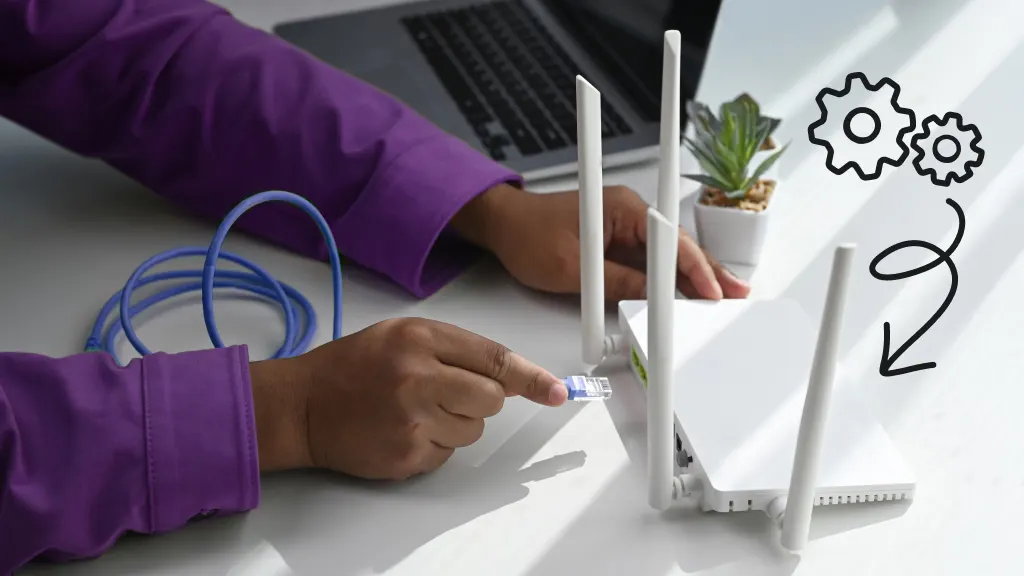How to set up a home network

To fully enjoy online activities from your home, you need a strong home network. Regardless of your specific needs, getting a grip on the basics of home networking is crucial for continuous connectivity and improving your internet experiences.
At Asurion, we’re here to help at every step of your tech journey. From tech care and repair to the basics—like tackling home network setup. We’ve got you covered.
What is a home network?
A home network connects all your devices—desktop computers, laptops, printers, smartphones, gaming consoles, and smart home devices—to the internet and each other. This network allows devices within your home to communicate, share resources, and access the internet. Setting up a network involves configuring a combination of hardware (like routers and modems) and software settings to ensure secure and efficient connectivity.
Types of home networks
Understanding the various types of home networks—wired, wireless, and hybrid—can help you choose the right setup for your specific needs.
Wired networks
Wired connections rely on Ethernet cables to connect your devices directly to your network router, offering stability and speed ideal for high-bandwidth activities, like gaming or streaming in high definition.
Wireless networks (Wi-Fi)
Most common in homes, Wi-Fi networks offer the convenience of connecting devices without cables. This network type requires a wireless router and is flexible, but it can be affected by distance, physical obstructions, and interference.
Hybrid networks
Combining wired and wireless elements, hybrid networks can optimize the strengths of both types, providing reliability where needed while extending wireless convenience to portable devices.

Tech troubles? We’re here to help.
Get 24/7 tech support, fast fixes, and more with Asurion Tech Care coverage.
How to set up a home network
Follow these straightforward steps to establish a reliable and efficient home network, ensuring all your devices stay connected.
1. Choose your network type
Now that you know the differences between networks, start by selecting your network type. Decide whether a wired, wireless, or hybrid network is best for your household.
2. Select the right equipment
Depending on your network type, you'll need a modem (often provided by your internet service provider (ISP) and a router. Sometimes, your modem and router will be combined into one device.
For Wi-Fi, consider a router that supports the latest standards (Wi-Fi 6) for better performance.
3. Set up your modem and router
Connect your modem to your service provider’s connection, then connect your router to the modem. This setup forms the gateway for all your devices to access the internet.
Whether your ISP provided one or you opted to buy your own, you’ll set up the modem and router using the manufacturer’s instructions.
4. Configure your router
Using a computer connected to your router, access the router’s admin page via the router’s IP address to configure network settings such as its SSID (network name) and password. Make sure to secure your network with WPA2 (Wi-Fi Protected Access 2) or WPA3 encryption.
You can expect to find all the information you need to access the admin page on your modem's underside (or back) label. Common addresses are 192.168.0.1, 192.168.1.1, or 192.168.2.1.
If your modem comes with a manual, you can check it there too.
Enter the default IP address of your router into a web browser's address bar and press Enter to access the router's admin panel and change any default passwords.
5. Connect devices
Depending on the type of network you've decided on, connect your devices to the network either through an Ethernet port or wireless connection. . Make sure each device is configured to join the network automatically.
6. Test your network
Once everything is connected, test your network by accessing the internet on different devices. Check for connectivity issues and coverage gaps—especially in a wireless setup.
7. Extend your range
You’ll usually see the modem installed in either the main living area of your home, like the living room. These placements are intended to be a general catch-all Wi-Fi area.
Depending on your home's square footage or layout, you might have to take an extra step to extend the Wi-Fi coverage range so users furthest away from the modem can access the internet. You could use a network extender to amplify the network coming from the router.
Tech is expensive. Protect it all.
Protect the devices your family loves and relies on with one simple plan. Asurion Tech Care covers your phones, computers, TVs, tablets, smart devices, and even your large appliances—plus, 24/7 live support for your tech care needs. Don't let breaks and malfunctions set you back with one plan flexible enough to fit your home and your budget. Learn more about peace-of-mind protection with Asurion Tech Care plans.
The Asurion® trademarks and logos are the property of Asurion, LLC. All rights reserved. All other trademarks are the property of their respective owners. Asurion is not affiliated with, sponsored by, or endorsed by any of the respective owners of the other trademarks appearing herein.